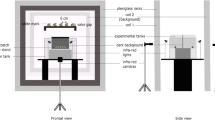Abstract
Extremely low frequency magnetic field (ELF-MF), as a ubiquitous ecophysiological factor, has been determined to influence the health of human and animals worldwide. In this study, we focused on the effects of ELF-MF on growth performance and digestive enzyme activity in juvenile tilapia, Oreochromis niloticus. Totally 450 fish were exposed to ELF-MF (50 Hz; 0, 30, 100, 150 and 200 μT) for 30 days, respectively. The effects on growth and digestion were monitored on the 10th, 20th, and 30th day after induction (immediate effect), as well as 20th day after cessation of exposure (delayed effect). The activities of pepsin and intestinal protease of tilapia were significantly decreased after exposure in certain intensities of ELF-MF, but recovered when the ELF-MF exposure was removed 20 days later. Similar effects were also observed in the growth parameters, moreover interestingly, the specific growth rate (SGR) even represented a compensatory growth. To our knowledge, the present research provides the first determination that a certain extent of ELF-MF exposure could inhibit the growth and digestion of fish, and cause compensatory restorations after being removed upon a time.




Similar content being viewed by others
References
Brown M (1957) Experimental studies on growth. In: Brown M (ed) The physiology of fishes. Academic Press, New York, pp 361–400
Cameron I, Hunter K, Winters W (1985) Retardation of embryogenesis by extremely low frequency 60 Hz electromagnetic fields. Physiol Chem Phys Med NMR 17(1):135–138
Chung MK, Kim JC, Myung SH, Lee DI (2003) Developmental toxicity evaluation of ELF magnetic fields in Sprague–Dawley rats. Bioelectromagnetics 24(4):231–240. doi:10.1002/bem.10114
Davis L (1962) Bibliography of biological effects of magnetic fields
Fatigoni C, Dominici L, Moretti M, Villarini M, Monarca S (2005) Genotoxic effects of extremely low frequency (ELF) magnetic fields (MF) evaluated by the Tradescantia-micronucleus assay. Environ Toxicol 20(6):585–591
Formicki K, Winnicki A (1998) Reactions of fish embryos and larvae to constant magnetic fields. Ital J Zool 65(S1):479–482
Fransson T, Jakobsson S, Johansson P, Kullberg C, Lind J, Vallin A (2001) Bird migration: magnetic cues trigger extensive refuelling. Nature 414(6859):35–36
Golovanova I, Talikina M (2006) On the impact of low concentrations of chlorophos in the period of early ontogenesis on digestive carbohydrases of underyearlings of roach Rutilus rutilus. J Ichthyol 46(5):404–408
Golovanova I, Filippov A, Krylov V, Chebotareva YV, Izyumov YG (2013) Effect of a magnetic field and copper upon activity of hydrolytic enzymes in roach (Rutilus rutilus) underyearlings. J Ichthyol 53(3):225–230
Hartwig V, Giovannetti G, Vanello N, Lombardi M, Landini L, Simi S (2009) Biological effects and safety in magnetic resonance imaging: a review. Int J Environ Res Public Health 6(6):1778–1798
Iuchi I, Yamagami K (1976) Induction of a precocious secretion of the hatching enzyme in the rainbow trout embryo by electric stimulation. Zool Mag 85(3):273–277
Janac B, Selakovic V, Raus S, Radenovic L, Zrnic M, Prolic Z (2012) Temporal patterns of extremely low frequency magnetic field-induced motor behavior changes in Mongolian gerbils of different age. Int J Radiat Biol 88(4):359–366. doi:10.3109/09553002.2012.652725
Juutilainen J (2005) Developmental effects of electromagnetic fields. Bioelectromagnetics 26(S7):S107–S115
Kaune W, Dovan T, Kavet R, Savitz D, Neutra R (2002a) Study of high- and low-current-configuration homes from the 1988 Denver childhood cancer study. Bioelectromagnetics 23(3):177–188
Kaune W, Miller M, Linet M, Hatch E, Kleinerman R, Wacholder S, Mohr A, Tarone R, Haines C (2002b) Magnetic fields produced by hand held hair dryers, stereo headsets, home sewing machines, and electric clocks. Bioelectromagnetics 23(1):14–25
Kavaliers M, Ossenkopp KP, Hirst M (1984) Magnetic fields abolish the enhanced nocturnal analgesic response to morphine in mice. Physiol Behav 32(2):261–264
Kolkovski S, Tandler A, Kissil GW, Gertler A (1993) The effect of dietary exogenous digestive enzymes on ingestion, assimilation, growth and survival of gilthead seabream (Sparus aurata, Sparidae, Linnaeus) larvae. Fish Physiol Biochem 12(3):203–209
Kunitz M (1947) Crystalline soybean trypsin inhibitor II. General properties. J Gen Physiol 30(4):291–310
Lai H, Carino M (1999) 60 Hz magnetic fields and central cholinergic activity: Effects of exposure intensity and duration. Bioelectromagnetics 20(5):284–289
Legros A, Corbacio M, Beuter A, Modolo J, Goulet D, Prato F, Thomas A (2012) Neurophysiological and behavioral effects of a 60 Hz, 1,800 μT magnetic field in humans. Eur J Appl Physiol 112(5):1751–1762
Mal AO (2005) Effect of the extremely low frequency, electromagnetic field on some behavioral aspects of Oreochromis Spilurus. Egypt J Aquat Res 31(2):373–382
Salzinger K, Freimark S, McCullough M, Phillips D, Birenbaum L (1990) Altered operant behavior of adult rats after perinatal exposure to a 60-Hz electromagnetic field. Bioelectromagnetics 11(2):105–116. doi:10.1002/bem.2250110202
Skauli KS, Reitan JB, Walther BT (2000) Hatching in zebrafish (Danio rerio) embryos exposed to a 50 Hz magnetic field. Bioelectromagnetics 21(5):407–410. doi:10.1002/1521-186x(200007)21:5<407::aid-bem10>3.0.co;2-v
Suzer C, Çoban D, Kamaci HO, Saka Ş, Firat K, Otgucuoğlu Ö, Küçüksari H (2008) Lactobacillus spp. bacteria as probiotics in gilthead sea bream (Sparus aurata, L.) larvae: effects on growth performance and digestive enzyme activities. Aquaculture 280(1):140–145
Walter H (1984) Proteinases: methods with hemoglobin, casein and azocoll as substrates. In: Bergmeyer H (ed) Methods of enzymatic analysis. Verlag Chemie, Weinheim, pp 270–277
Zimmerman S, Zimmerman AM, Winters WD, Cameron IL (1990) Influence of 60-Hz magnetic fields on sea urchin development. Bioelectromagnetics 11(1):37–45
Acknowledgments
This study was supported by Specialized Research Fund for the Doctoral Program of Higher Education (No. 20130142110016) and Science and Technology Project of SGCC (SG0860). The authors extend their gratitude to the China Electric Power Research Institute and Wuhan High Voltage Institute for the laboratory and experimental geomagnetic activity data.
Author information
Authors and Affiliations
Corresponding author
Rights and permissions
About this article
Cite this article
Li, Y., Ru, B., Liu, X. et al. Effects of extremely low frequency alternating-current magnetic fields on the growth performance and digestive enzyme activity of tilapia Oreochromis niloticus . Environ Biol Fish 98, 337–343 (2015). https://doi.org/10.1007/s10641-014-0263-6
Received:
Accepted:
Published:
Issue Date:
DOI: https://doi.org/10.1007/s10641-014-0263-6




